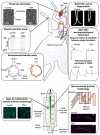Drosophila Models for Charcot-Marie-Tooth Neuropathy Related to Aminoacyl-tRNA Synthetases
- PMID: 34680913
- PMCID: PMC8536177
- DOI: 10.3390/genes12101519
Drosophila Models for Charcot-Marie-Tooth Neuropathy Related to Aminoacyl-tRNA Synthetases
Abstract
Aminoacyl-tRNA synthetases (aaRS) represent the largest cluster of proteins implicated in Charcot-Marie-Tooth neuropathy (CMT), the most common neuromuscular disorder. Dominant mutations in six aaRS cause different axonal CMT subtypes with common clinical characteristics, including progressive distal muscle weakness and wasting, impaired sensory modalities, gait problems and skeletal deformities. These clinical manifestations are caused by "dying back" axonal degeneration of the longest peripheral sensory and motor neurons. Surprisingly, loss of aminoacylation activity is not a prerequisite for CMT to occur, suggesting a gain-of-function disease mechanism. Here, we present the Drosophila melanogaster disease models that have been developed to understand the molecular pathway(s) underlying GARS1- and YARS1-associated CMT etiology. Expression of dominant CMT mutations in these aaRSs induced comparable neurodegenerative phenotypes, both in larvae and adult animals. Interestingly, recent data suggests that shared molecular pathways, such as dysregulation of global protein synthesis, might play a role in disease pathology. In addition, it has been demonstrated that the important function of nuclear YARS1 in transcriptional regulation and the binding properties of mutant GARS1 are also conserved and can be studied in D. melanogaster in the context of CMT. Taken together, the fly has emerged as a faithful companion model for cellular and molecular studies of aaRS-CMT that also enables in vivo investigation of candidate CMT drugs.
Keywords: Charcot–Marie–Tooth neuropathy; Drosophila melanogaster; aminoacyl-tRNA synthetases; disease-modeling.
Conflict of interest statement
The authors declare no conflict of interest.
Figures


Similar articles
-
Neurodegenerative Charcot-Marie-Tooth disease as a case study to decipher novel functions of aminoacyl-tRNA synthetases.J Biol Chem. 2019 Apr 5;294(14):5321-5339. doi: 10.1074/jbc.REV118.002955. Epub 2019 Jan 14. J Biol Chem. 2019. PMID: 30643024 Free PMC article. Review.
-
Peripheral neuropathy via mutant tRNA synthetases: Inhibition of protein translation provides a possible explanation.Bioessays. 2016 Sep;38(9):818-29. doi: 10.1002/bies.201600052. Epub 2016 Jun 28. Bioessays. 2016. PMID: 27352040 Free PMC article. Review.
-
Aminoacyl-tRNA synthetases in Charcot-Marie-Tooth disease: A gain or a loss?J Neurochem. 2021 May;157(3):351-369. doi: 10.1111/jnc.15249. Epub 2020 Dec 19. J Neurochem. 2021. PMID: 33236345 Free PMC article. Review.
-
Transcriptional dysregulation by a nucleus-localized aminoacyl-tRNA synthetase associated with Charcot-Marie-Tooth neuropathy.Nat Commun. 2019 Nov 6;10(1):5045. doi: 10.1038/s41467-019-12909-9. Nat Commun. 2019. PMID: 31695036 Free PMC article.
-
CMT disease severity correlates with mutation-induced open conformation of histidyl-tRNA synthetase, not aminoacylation loss, in patient cells.Proc Natl Acad Sci U S A. 2019 Sep 24;116(39):19440-19448. doi: 10.1073/pnas.1908288116. Epub 2019 Sep 9. Proc Natl Acad Sci U S A. 2019. PMID: 31501329 Free PMC article.
Cited by
-
An Adapted GeneSwitch Toolkit for Comparable Cellular and Animal Models: A Proof of Concept in Modeling Charcot-Marie-Tooth Neuropathy.Int J Mol Sci. 2023 Nov 9;24(22):16138. doi: 10.3390/ijms242216138. Int J Mol Sci. 2023. PMID: 38003325 Free PMC article.
-
Tyrosyl-tRNA synthetase has a noncanonical function in actin bundling.Nat Commun. 2023 Mar 8;14(1):999. doi: 10.1038/s41467-023-35908-3. Nat Commun. 2023. PMID: 36890170 Free PMC article.
-
Case Report: A new case of YARS1-associated autosomal recessive disorder with compound heterozygous and concurrent 47, XXY.Front Pediatr. 2023 Dec 6;11:1282253. doi: 10.3389/fped.2023.1282253. eCollection 2023. Front Pediatr. 2023. PMID: 38125821 Free PMC article.
-
Dominant aminoacyl-tRNA synthetase disorders: lessons learned from in vivo disease models.Front Neurosci. 2023 May 12;17:1182845. doi: 10.3389/fnins.2023.1182845. eCollection 2023. Front Neurosci. 2023. PMID: 37274211 Free PMC article. Review.
-
An asymmetric structure of bacterial TrpRS supports the half-of-the-sites catalytic mechanism and facilitates antimicrobial screening.Nucleic Acids Res. 2023 May 22;51(9):4637-4649. doi: 10.1093/nar/gkad278. Nucleic Acids Res. 2023. PMID: 37070195 Free PMC article.
References
-
- Tooth H.H. The Peroneal Type of Progressive Muscular Atrophy. University of Cambridge; London, UK: 1886. - PubMed
-
- Charcot J.M. Sur une forme paticuliere d’atrophie musuculaire progressive souvent familial, debutante par les pieds et les jambes et atteignant plus tard les mains. Rev. Med. Fr. 1886;6:97–138.
Publication types
MeSH terms
Substances
LinkOut - more resources
Full Text Sources
Medical
Molecular Biology Databases
Miscellaneous

